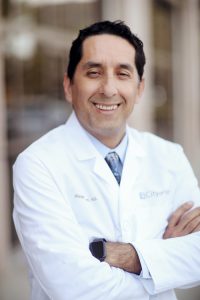
By Misagh Karimi, M.D., City of Hope Newport Beach
Prostate cancer is the most common men’s cancer, affecting one in eight men. If it is detected before it has spread to other parts of the body, the likelihood of successful treatment is high. But there are several myths and misconceptions about prostate cancer that need to be corrected. Here are some of them:
Myth No. 1: Prostate cancer only affects older men.
Truth: Although prostate cancer is diagnosed at an average age of around 66 years, recent studies show the disease is increasing in younger men. This is known as early onset prostate cancer.
Myth No. 2: It’s OK to put off prostate cancer screenings if I don’t have any symptoms.
Truth: You and your primary care physician or urologist should decide together whether or when you should get screened and which testing option is right for you. Screening is how most early-stage prostate cancers are found, since symptoms often do not arise until the cancer is more advanced. Your age, overall health, family history, or personal preferences may also play a role in the decision.
Myth No. 3: A high PSA score means I have prostate cancer.
Truth: Not necessarily. High levels of prostate-specific antigen (PSA) in the blood can be a sign of prostate cancer but can also be caused by other conditions, such as an enlarged prostate. If the results of your PSA test are not normal, your doctor may recommend further testing and will work with you to figure out what to do next.
Myth No. 4: No one in my family has had prostate cancer, so I won’t get it.
Truth: Most men who develop prostate cancer have no family history of it, although genetics do play a role. Some estimates are that when prostate cancer runs in the family it increases the odds of developing the disease to one in three.
Myth No. 5: Prostate cancer always requires treatment.
Truth: If you have early-stage, slow-growing prostate cancer, you may be able to forego immediate treatment in favor of active surveillance or a wait-and-watch approach. Active surveillance is close monitoring that includes regular testing and imaging. Watchful waiting usually involves fewer tests. In both approaches, you and your doctor can decide if treatment is needed if your test results or symptoms change.
Myth No. 6: There’s nothing I can do to reduce my risk of getting prostate cancer.
Truth: There is evidence that making healthy lifestyle choices may reduce the risk of prostate cancer. Get into the habit of exercising regularly (with your doctor’s approval), eating more fruits and vegetables each day, reducing your intake of saturated fat and red meat, and increasing your intake of whole grains and healthy fats like omega-3 fatty acids.
Misagh Karimi, M.D., is a medical oncologist and director of clinical operations at City of Hope Newport Beach Fashion Island. He has two decades of experience, and chose oncology because it’s a fast-paced, constantly-evolving field with many exciting new developments.




